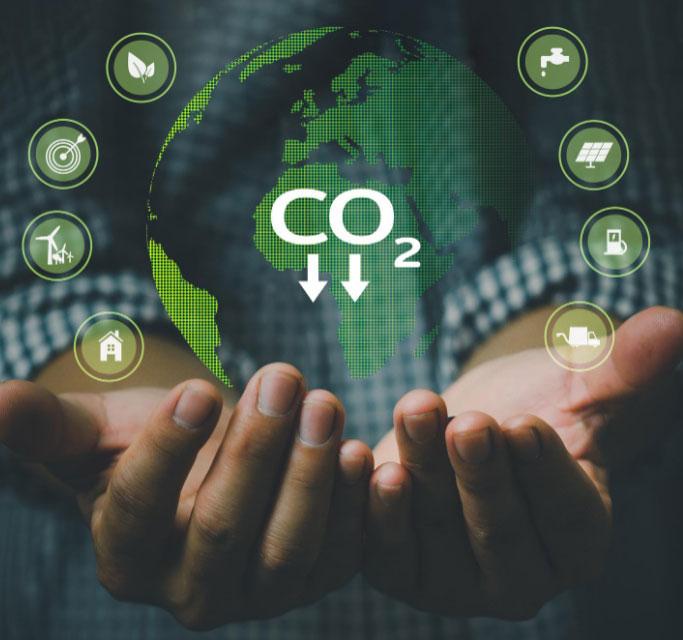Carbon Mechanisms

Increasing Importance of Climate Change Mitigation
Individuals and Corporations around the world are increasingly recognizing the importance of reducing their GHG emissions as a definitive response to Climate Change in order to achieve the target of The Paris Agreement that sets out a global framework to avoid dangerous climate change by limiting global warming to well below 2°C and pursuing efforts to limit it to 1.5°C compared to pre-industrial levels.
As a result, many of them are reducing their carbon footprints through energy efficiency and other measures. Quite often, however, it is not possible for these entities to meet their targets or eliminate their carbon footprint, at least in the near term, with internal reductions alone, and they need a flexible mechanism to achieve these aspirational goals. They enter the Carbon Markets that offer plethora of choices i.e. Carbon Mechanisms to select from.

Carbon Markets for Managing Footprint
Many of them are reducing their carbon footprints through energy efficiency and other measures. Quite often, however, it is not possible for these entities to meet their targets or eliminate their carbon footprint, at least in the near term, with internal reductions alone, and they need a flexible mechanism to achieve these aspirational goals. They enter the Carbon Markets that offer plethora of choices i.e. Carbon Mechanisms to select from.
Carbon Markets facilitate Global Trading of Emissions Reductions Units
Through the Carbon Markets, entities can neutralize, or offset, their emissions by retiring carbon credits generated by projects that are reducing GHG emissions elsewhere. Of course, it is critical to ensure, or verify, that the emissions reductions generated by these projects are actually occurring and are genuine. This is where it becomes incumbent upon various Carbon Mechanisms to ensure the credibility of Emission Reduction Projects.
Carbon Mechanisms
Viviid Emissions Reductions Universal Private Limited has a long standing and proven track record of getting various genres of Renewable Energy Projects validated (accredited) under appropriate Carbon Mechanisms like:
-
Clean Development Mechanism (CDM)
This runs under the aegis of United Nations that allows emission-reduction projects in developing countries to earn certified emission reduction (CER) credits, each equivalent to one tonne of CO2. These CERs can be traded and sold, and used by industrialized countries to a meet a part of their emission reduction targets under the Kyoto Protocol.
-
Gold Standard
This was established by the World Wildlife Fund and several international NGOs as a crediting mechanism for both voluntary offsetting and additional certification on the social impacts of CERs. As such, it has a particular focus on generating co-benefits from the Sustainable Development Goals, such as employment, empowerment, education and health improvements for local communities, alongside emission reductions from its projects. There are strict requirements relating to the demonstration of appropriate safeguards to ensure these co-benefits are realized.
-
Verified Carbon Standard (VCS)
This was founded by several key carbon market actors including The Climate Group, the International Emissions Trading Association, the World Business Council for Sustainable Development, and the World Economic Forum. Its initial purpose was to certify and credit voluntary emission reduction projects. While the main use of Voluntary Carbon Units VCUs is still predominantly for voluntary offsetting, over 17 million VCUs from VCS projects have been used for compliance under the Colombia carbon tax.
-
Universal Carbon Registry
This aims to introduce better carbonomics with the next-generation model of mining voluntary non-compliance carbon credits from a wide range of green projects that is far more efficient, faster, cheaper, de-centralized in transfer and convenient for every small green project owner aiming to decarbonize the economy. The UCR, issues voluntary non-compliance carbon credits called carbon offset units (CoUs), to projects that result in the destruction, avoidance or reduction of GHG emissions in the atmosphere, and to certain carbon sequestration initiatives. UCR has designed and reset the eligibility criteria to reward sustainable development, with rules that are standardized and facilitates carbon finance/capital flows in the traditional as well as emerging smart contract conversion (CoU Token) tokenomics post issuance of the carbon credits on the registry.
-
And many more to come!
